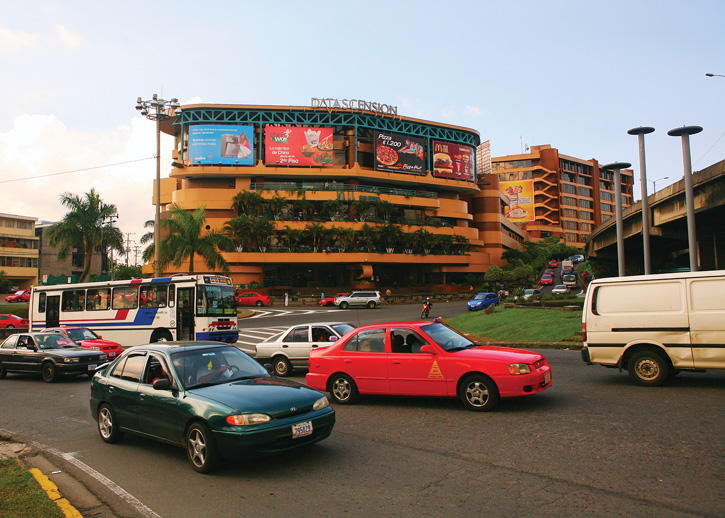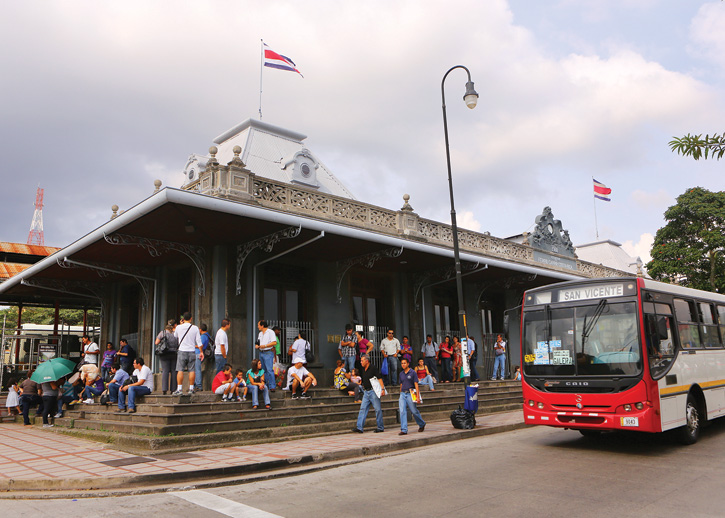Getting around San José is very easy if you’re in the know and extremely frustrating if you aren’t. Most places are quickly and easily reached by taxi, by bus, or on foot. Here’s what you need to know before renting a car, the ins and outs of public transportation in Costa Rica, and how to safely travel by taxi.
Car rental agencies in San José are concentrated along Paseo Colón. But don’t even think about using a rental car for travel within San José; it entails too many headaches. Note that Paseo Colón, normally with two-way traffic, is one-way only—eastbound—6:30am-8:30am weekdays.
A peripheral highway (circunvalación) passes around the south and east sides of San José.
All noncommercial private vehicles are banned from metropolitan San José 6am-7pm weekdays, based on the last number of their vehicle license plate.Costa Rica implemented a pico y placa (“rush hour and license plate”) law in 2005 as a way of reducing traffic congestion. All noncommercial private vehicles are banned from metropolitan San José 6am-7pm weekdays, based on the last number of their vehicle license plate, as follows: Monday 1 and 2; Tuesday 3 and 4; Wednesday 5 and 6; Thursday 7 and 8; Friday 9 and 0. Foreign visitors are not exempt. However, exemptions are made for cars owned by individuals with disabilities, buses, taxis, and motorcycles. Fines are currently about $13, but violators can supposedly be fined as often as they are pulled over on any given day.
Most places in San José, such as Mall San Pedro, are quickly and easily reached by taxi, by bus, or on foot. Photo © Christopher P. Baker.
Private parking lots offer secure 24-hour parking; you must leave your ignition key with the attendant. Never park in a no-parking zone, marked “Control por Grúa” (controlled by tow truck). Regulations are efficiently enforced.
Break-ins and theft are common; rental cars are especially vulnerable. Never leave anything of value in your car, even in the trunk.
San José has an excellent network of privately owned local bus services. Most buses operate 5am-10pm daily, with frequency of service determined by demand. Downtown and suburban San José buses operate every few minutes. Buses to the suburbs often fill up, so it’s best to board at their principal downtown parada, designated by a sign, “Parada de Autobuses,” showing the route name and number.
A sign in the windshield tells the route number and destination. Fares are marked by the doors and are collected when you board. Drivers provide change and tend to be honest. Buses cost 125-250 colones ($0.25-0.50) downtown and less than 100 colones elsewhere within the metropolitan area.
From the west, the most convenient bus into town is the Sabana-Cementerio service (route 2), which runs counterclockwise between Sabana Sur and downtown along Avenida 10, then back along Avenida 3 (past the Coca-Cola bus station) and Paseo Colón. The Cementerio-Estadio service (route 7) runs in the opposite direction along Paseo Colón and Avenida 2 and back along Avenida 12. Both take about 40 minutes to complete the circle.
Buses to Los Yoses and San Pedro run east along Avenida 2 and, beyond Calle 29, along Avenida Central. Buses to Coronado begin at Calle 3, Avenidas 5/7; to Guadalupe at Avenida 3, Calles Central/1; to Moravia from Avenida 3, Calles 3/5; and to Pavas from Avenida 1, Calle 18. Buses to Escazú depart Ave. 6, Calles 14/16 and also from Calle 16, Avenidas 1/3 every 30 minutes or so.
Be wary of pickpockets on buses.

A bus passing by the Estación Ferrocarril Atlántico, in San José, Costa Rica. Photo © Christopher P. Baker.
A great way to beat the cross-town traffic is to hop on the Tren Interurbano commuter train that links Pavas (on the west side of town) with San Pedro (on the east side). Trains depart the Estación Ferrocarril Pacífico (Pacific Station, Ave. 20, Calle Central/7, tel. 506/2257-6161) and operate six times daily Monday-Friday and three times daily Saturday-Sunday ($0.25) in each direction, stopping at or near the U.S. Embassy, La Salle (south side of Parque la Sabana), and Universidad de Costa Rica (University of Costa Rica). Another service links the Estación Ferrocarril Atlántico (Atlantic Station, Ave. 3, Calle 21, no tel.) to Heredia, with 15 daily departures; a third service leaves the same station three times daily for Cartago.
Licensed taxis are red (taxis exclusively serving Juan Santamaría Airport are orange); if it’s any other color or lacks the inverted yellow triangle on the doors, it’s a “pirate” taxi operating illegally. You can travel anywhere within the city for less than $8. The official rate at press time was 605 colones ($1.15) per kilometer. By law, taxi drivers (who must display a business card with their name, license plate, and other details) must use their meters (marias) for journeys of less than 12 kilometers (7.5 miles), but few do. Always demand that the taxi driver use the meter; otherwise you’re going to get ripped off. A 20 percent surcharge is allowed at night. You do not normally tip taxi drivers in Costa Rica, but you can give your taxi driver any small change remaining after you pay the fare.
Finding a taxi is usually not a problem, except during rush hour and when it’s raining. One of the best places is Parque Central, where they line up on Avenida 2, and in front of the Gran Hotel and Teatro Nacional, two blocks east. Avoid hailing a taxi on the street, as many drivers work in cahoots with robbers who hop into the cab. For a taxi, call Coopetaxi (tel. 506/2235-9966) or Coopetico (tel. 506/2224-7979).
There are reports of taxi drivers making sexual advances toward single women; this is more likely to happen with pirate taxis, which you should always avoid. Few taxis have functioning seat belts.
Excerpted from the Tenth Edition of Moon Costa Rica.